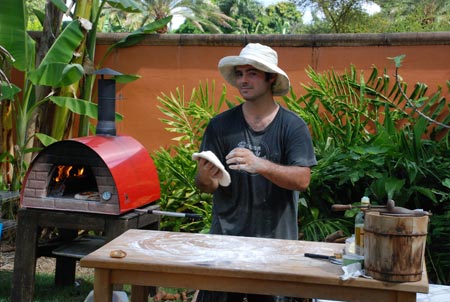(part 2 of 2)
There was plenty at GrowFest! to feed your body, mind and soul. Maybe the best part was all the delicious locavore treats. You could seriously nibble your way from one end of the festival to the other and leave with a full belly.
Front and center, right when you entered the park, was the Urban Oasis Project’s tent where Melissa Contreras, Art Friedrich and Carl Templar set up a mini farmer’s market. Tables were piled with all kinds of fresh local produce in season — starfruit, dragon fruit, longans, jackfruit, okra, eggplant, avocados, tomatoes, baby arugula, seminole pumpkin, plus oyster mushrooms, raw honey, organic rice and heirloom tomato seedlings. If you were hungry, you could dig into an addictive bag of Shawnee’s Greenthumb spirulina popcorn. And, if you’re hungry for knowledge, Melissa’s book “Organic Methods for Vegetable Gardening in South Florida” is a useful resource geared for South Florida gardener. (You can find it at the Upper Eastside and Southwest farmers markets, or get it on Amazon.)
This year, GrowFest! donated over $1000 to Urban Oasis, and Melissa was thrilled by the gift. “We will use those funds for food and nutrition education at the Verde market,” she said. Her non-profit was recently given a contract to manage the market and farm at Verde Gardens, a low-income housing community in Homestead. Urban Oasis operates several farmers markets in underserved neighborhoods. Event organizer Margie Pikarsky said, “This year I chose Urban Oasis Project for their efforts to bring affordable food to underserved communities. I decided that each year the event will benefit a nonprofit organization which supports/promotes/educates about local food and local agriculture.”
Delicious aromas of wood fired pizza — yes, pizza! — wafted through the festival. Chef Jon Gabino of Three Sisters Farm brought his pizza oven, pizza dough, and carefully stacked wood next to his work table. Jon’s hands danced with circles of dough, and finished pizzas flew out of the oven as fast as he could make them. Rachael Middleton offered roselle and lemongrass teas and jaboticaba sorbet to complete the meal. Pizza is one of many vegetarian dishes that Three Sisters Farm offers on their Saturday night Farm Meal. Nearly everything on the menu is super local, sourced from the farm or growers nearby. Make your reservations online here.
At the demo tent, there was lots of information to feed your mind. Workshops were scheduled through both days on many gardening topics. Urban beekeeper Rigo De La Portilla spoke on backyard beekeeping. He is one of several local beekeepers who captures swarms and home infestations without killing bees. Other popular talks were on plant propagation, growing mangoes, vermicomposting (using red wiggler worms to make compost), raising chickens, and setting up a rain barrel.
No festival is complete with without music. This year, music students from Robert Morgan Educational Center’s string quartet performed on Saturday. They had so much fun last year they came back again, and brought the jazz combo with them. On Sunday, members of the South Florida Bluegrass Society livened things up with their old timey tunes.
The celebrity sighting, as it were, came on Sunday afternoon. As I was hanging out by the Extension tent, Congressman Joe Garcia, accompanied by Kevin Chambliss, sauntered into the park and started greeted people. Everybody ran to take a picture with the congressman. You know that your event is on the map when local politicians come to visit!
GrowFest! will be back at the Fruit and Spice Park next year, bigger and better. See you there!

Cuckita “Cookie” Bellande and her daughter of Rochelois Jams

Tom from Florida Keys Sea Salt offers a sampling of salt on an apple slice.






























